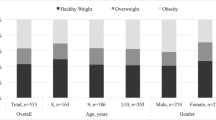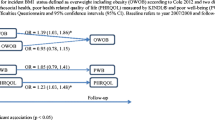Abstract
Purpose
In obesity prevention, understanding psychosocial influences in early life is pivotal. Reviews reported contradictory results and a lack of longitudinal studies focusing on underlying lifestyle factors. This study tested whether psychosocial Quality-Of-Life (QOL) was associated with pre-schoolers’ lifestyle and adiposity changes over one school year and whether lifestyle moderated the latter. It was hypothesised that QOL might not impact adiposity in everybody but that this might depend on preceding lifestyle.
Method
Longitudinal data from 291 Swiss pre-schoolers (initially 3.9–6.3 years) was available. The following measures were used in longitudinal regressions: psychosocial QOL by PedsQL, adiposity (BMI z-score, waist, fat%), diet (food frequency), sedentary time and accelerometer-based activity.
Results
Concerning lifestyle, low psychosocial QOL was only related to unfavourable changes in diet (less fruit β = 0.21 and more fat intake β = −0.28) and lower physical activity (β = 0.21). Longitudinal QOL-adiposity relations appeared only after moderation by lifestyle factors (beta-range 0.13–0.67). Low psychosocial QOL was associated with increased adiposity in children with an unhealthy diet intake or high sedentary time. By contrast, low psychosocial QOL was associated with decreasing adiposity in high fruit consumers or more physically active pre-schoolers.
Conclusion
Results emphasise the need for testing moderation in the QOL-adiposity relation. An unhealthy diet can be a vulnerability factor and high physical activity a protective factor in QOL-related adiposity. Consequently, QOL and lifestyle should be targeted concurrently in multi-factorial obesity prevention. The environment should be an ‘activity encouraging, healthy food zone’ that minimises opportunities for stress-induced eating. In addition, appropriate stress coping skills should be acquired.

Similar content being viewed by others
References
Moreno L, Pigeot I, Ahrens W, editors. Epidemiology of obesity in children and adolescents—prevalence and etiology. London: Springer; 2011.
Karasu SR. Of mind and matter: psychological dimensions in obesity. Am J Psychother. 2012;66(2):111–28.
Puder JJ, Munsch S. Psychological correlates of childhood obesity. Int J Obes. 2010;34:S37–43. doi:10.1038/Ijo.2010.238.
Wilson SM, Sato AF. Stress and paediatric obesity: what we know and where to go. Stress Health. 2013. doi:10.1002/smi.2501.
Pervanidou P, Chrousos GP. Stress and obesity/metabolic syndrome in childhood and adolescence. Int J Pediatr Obes. 2011;6 Suppl 1:21–8. doi:10.3109/17477166.2011.615996.
Incledon E, Wake M, Hay M. Psychological predictors of adiposity: systematic review of longitudinal studies. Int J Pediatr Obes. 2011;6(2–2):e1–11. doi:10.3109/17477166.2010.549491.
Liem E, Stolk R, Oldehinkel A, Sauer P. The association between depressive symptoms in childhood and overweight in adolescence. The TRAILS study. Horm Res. 2008;70:65–6.
Gatineau M, Dent M. Obesity and mental health. Oxford: National Obesity Observatory; 2011.
Tsatsoulis A, Fountoulakis S. The protective role of exercise on stress system dysregulation and comorbidities. Ann N Y Acad Sci. 2006;1083:196–213. doi:10.1196/annals.1367.020.
Balantekin KN, Roemmich JN. Children’s coping after psychological stress. Choices among food, physical activity, and television. Appetite. 2012;59(2):298–304. doi:10.1016/j.appet.2012.05.016.
Biddle SJ, Asare M. Physical activity and mental health in children and adolescents: a review of reviews. Br J Sports Med. 2011;45(11):886–95. doi:10.1136/bjsports-2011-090185.
Kappos AD. The impact of electronic media on mental and somatic children’s health. Int J Hyg Environ Health. 2007;210(5):555–62. doi:10.1016/j.ijheh.2007.07.003.
Adam TC, Epel ES. Stress, eating and the reward system. Physiol Behav. 2007;91(4):449–58. doi:10.1016/j.physbeh.2007.04.011.
Dallman MF, Pecoraro N, Akana SF, et al. Chronic stress and obesity: a new view of “comfort food”. Proc Nat Acad Sci U S A. 2003;100(20):11696–701. doi:10.1073/pnas.1934666100.
Epel E, Tomiyama AJ, Dallman MF. Stress and reward neural networks, eating, and obesity. In: Brownell K, Gold M, editors. Handbook of food and addiction. 2012. p. 462.
Gibson EL. Emotional influences on food choice: sensory, physiological and psychological pathways. Physiol Behav. 2006;89(1):53–61. doi:10.1016/j.physbeh.2006.01.024.
Chen X, Sekine M, Hamanishi S, et al. Lifestyles and health-related quality of life in Japanese school children: a cross-sectional study. Prev Med. 2005;40(6):668–78. doi:10.1016/j.ypmed.2004.09.034.
Lammle L, Woll A, Mensink GB, Bos K. Distal and proximal factors of health behaviors and their associations with health in children and adolescents. Int J Environ Res Public Health. 2013;10(7):2944–78. doi:10.3390/ijerph10072944.
Jacka FN, Kremer PJ, Berk M, et al. A prospective study of diet quality and mental health in adolescents. PLoS One. 2011;6(9), e24805. doi:10.1371/journal.pone.0024805.
Epel E, Lapidus R, McEwen B, Brownell K. Stress may add bite to appetite in women: a laboratory study of stress-induced cortisol and eating behavior. Psychoneuroendocrinology. 2001;26(1):37–49.
Macht M. How emotions affect eating: a five-way model. Appetite. 2008;50(1):1–11. doi:10.1016/j.appet.2007.07.002.
Roemmich JN, Gurgol CM, Epstein LH. Influence of an interpersonal laboratory stressor on youths’ choice to be physically active. Obes Res. 2003;11(9):1080–7. doi:10.1038/oby.2003.148.
Becker JB, Berkley KJ, Geary N, Hampson E, Herman JP, Young EA. Sex differences in the brain: from genes to behavior. New York: Oxford University Press; 2008.
Reinfjell T, Hjemdal O, Aune T, Vikan A, Diseth TH. The Pediatric Quality of Life Inventory (PedsQL) 4.0 as an assessment measure for depressive symptoms: a correlational study with young adolescents. Nord J Psychiatry. 2008;62(4):279–86. doi:10.1080/08039480801983950.
Cameron AJ, Magliano DJ, Dunstan DW, et al. A bi-directional relationship between obesity and health-related quality of life: evidence from the longitudinal AusDiab study. Int J Obes (Lond). 2012;36(2):295–303. doi:10.1038/ijo.2011.103.
Tsiros MD, Olds T, Buckley JD, et al. Health-related quality of life in obese children and adolescents. Int J Obes (Lond). 2009;33(4):387–400. doi:10.1038/ijo.2009.42.
Puder J, Pinto AM, Bonvin A, et al. Health-related quality of life in migrant preschool children. BMC Public Health. 2013;13(1):384. doi:10.1186/1471-2458-13-384.
Chan CM, Wang WC. Quality of life in overweight and obese young Chinese children: a mixed-method study. Health Qual Life Outcomes. 2013;11:33. doi:10.1186/1477-7525-11-33.
Jansen PW, Mensah FK, Clifford S, Nicholson JM, Wake M. Bidirectional associations between overweight and health-related quality of life from 4–11 years: Longitudinal Study of Australian Children. Int J Obes. 2013;37(10):1307–13. doi:10.1038/Ijo.2013.71.
Sawyer MG, Harchak T, Wake M, Lynch J. Four-year prospective study of BMI and mental health problems in young children. Pediatrics. 2011;128(4):677–84. doi:10.1542/peds.2010-3132.
Williams JW, Canterford L, Hesketh KD, et al. Changes in body mass index and health related quality of life from childhood to adolescence. Int J Pediatr Obes. 2011;6(2–2):e442–8. doi:10.3109/17477166.2010.526226.
Michels N, Sioen I, Boone L, et al. Cross-lagged associations between children’s stress and adiposity: The Children’s Body Composition and Stress Study. Psychosom Med. 2015;77(1):50–8. doi:10.1097/psy.0000000000000122.
Yin ZN, Davis CL, Moore JB, Treiber FA. Physical activity buffers the effects of chronic stress on adiposity in youth. Ann Behav Med. 2005;29(1):29–36. doi:10.1207/s15324796abm2901_5.
Niederer I, Kriemler S, Zahner L, et al. Influence of a lifestyle intervention in preschool children on physiological and psychological parameters (Ballabeina): study design of a cluster randomized controlled trial. Bmc Public Health. 2009;9:94. doi:10.1186/1471-2458-9-94.
Varni JW, Burwinkle TM, Seid M, Skarr D. The PedsQL (TM) 4.0 as a pediatric population health measure: feasibility, reliability, and validity. Ambul Pediatr. 2003;3(6):329–41. doi:10.1367/1539-4409(2003)003<0329:Tpaapp>2.0.Co;2.
Varni JW, Seid M, Kurtin PS. PedsQL (TM) 4.0: reliability and validity of the Pediatric Quality of Life Inventory (TM) version 4.0 generic core scales in healthy and patient populations. Med Care. 2001;39(8):800–12. doi:10.1097/00005650-200108000-00006.
Varni JW, Burwinkle TM, Seid M. The PedsQL (TM) 4.0 as a school population health measure: feasibility, reliability, and validity. Qual Life Res. 2006;15(2):203–15. doi:10.1007/s11136-005-1388-z.
Ebenegger V, Marques-Vidal P, Barral J, Kriemler S, Puder JJ, Nydegger A. Eating habits of preschool children with high migrant status in Switzerland according to a new food frequency questionnaire. Nutr Res. 2010;30(2):104–9. doi:10.1016/j.nutres.2010.01.006.
Huybrechts I, De Backer G, De Bacquer D, Maes L, De Henauw S. Relative validity and reproducibility of a food-frequency questionnaire for estimating food intakes among Flemish preschoolers. Int J Environ Res Public Health. 2009;6(1):382–99. doi:10.3390/ijerph6010382.
Pate RR, Almeida MJ, McIver KL, Pfeiffer KA, Dowda M. Validation and calibration of an accelerometer in preschool children. Obesity. 2006;14(11):2000–6. doi:10.1038/Oby.2006.234.
Evenson KR, Catellier DJ, Gill K, Ondrak KS, McMurray RG. Calibration of two objective measures of physical activity for children. J Sports Sci. 2008;26(14):1557–65. doi:10.1080/02640410802334196.
Cole TJ, Freeman JV, Preece MA. British 1990 growth reference centiles for weight, height, body mass index and head circumference fitted by maximum penalized likelihood. Stat Med. 1998;17(4):407–29. doi:10.1002/(SICI)1097-0258(19980228)17:4<407::AID-SIM742>3.0.CO;2-L [pii].
Ashwell M, Hsieh SD. Six reasons why the waist-to-height ratio is a rapid and effective global indicator for health risks of obesity and how its use could simplify the international public health message on obesity. Int J Food Sci Nutr. 2005;56(5):303–7. doi:10.1080/09637480500195066.
Mokha JS, Srinivasan SR, Dasmahapatra P, et al. Utility of waist-to-height ratio in assessing the status of central obesity and related cardiometabolic risk profile among normal weight and overweight/obese children: the Bogalusa Heart Study. BMC Pediatr. 2010;10:73. doi:10.1186/1471-2431-10-73.
NIH. Bioelectrical impedance analysis in body composition measurement: National Institutes of Health Technology assessment conference statement—December 12–14, 1994. Am J Clin Nutr. 1996;64(3):S524–S32.
Schaefer F, Georgi M, Zieger A, Scharer K. Usefulness of bioelectric impedance and skinfold measurements in predicting fat-free mass derived from total body potassium in children. Pediatr Res. 1994;35(5):617–24.
Burgi F, Meyer U, Granacher U, et al. Relationship of physical activity with motor skills, aerobic fitness and body fat in preschool children: a cross-sectional and longitudinal study (Ballabeina). Int J Obes. 2011;35(7):937–44. doi:10.1038/Ijo.2011.54.
Little RJA. A test of missing completely at random for multivariate data with missing values. J Am Stat Assoc. 1988;83(404):1198–202. doi:10.2307/2290157.
Helm R, Mark A. Analysis and evaluation of moderator effects in regression models: state of art, alternatives and empirical example. Rev Manag Sci. 2012;6(4):307–32. doi:10.1007/s11846-010-0057-y.
Suchert V, Hanewinkel R, Isensee B. Sedentary behavior and indicators of mental health in school-aged children and adolescents: a systematic review. Prev Med. 2015;76:48–57. doi:10.1016/j.ypmed.2015.03.026.
Gopinath B, Louie JC, Flood VM, et al. Influence of obesogenic behaviors on health-related quality of life in adolescents. Asia Pac J Clin Nutr. 2014;23(1):121–7. doi:10.6133/apjcn.2014.23.1.13.
Michels N, Sioen I, Boone L, et al. Longitudinal association between child stress and lifestyle. Health Psychol. 2015;34(1):40–50.
Hampel P, Petermann F. Age and gender effects on coping in children and adolescents. J Youth Adolesc. 2005;34(2):73–83. doi:10.1007/s10964-005-3207-9.
Hatzinger M, Brand S, Perren S, von Wyl A, von Klitzing K, Holsboer-Trachsler E. Hypothalamic-pituitary-adrenocortical (HPA) activity in kindergarten children: importance of gender and associations with behavioral/emotional difficulties. J Psychiatr Res. 2007;41(10):861–70. doi:10.1016/j.jpsychires.2006.07.012.
Brasholt M, Chawes B, Kreiner-Moller E, Vahlkvist S, Sinding M, Bisgaard H. Objective assessment of levels and patterns of physical activity in preschool children. Pediatr Res. 2013;74(3):333–8. doi:10.1038/pr.2013.99.
Bradley RH, Houts R, Nader PR, O'Brien M, Belsky J, Crosnoe R. The relationship between body mass index and behavior in children. J Pediatr. 2008;153(5):629–34. doi:10.1016/j.jpeds.2008.05.026.
Griffiths LJ, Dezateux C, Hill A. Is obesity associated with emotional and behavioural problems in children? Findings from the Millennium Cohort Study. Int J Pediatr Obes. 2011;6(2–2):E423–E32. doi:10.3109/17477166.2010.526221.
Waladkhani AR, Hellhammer J. Dietary modification of brain function: effects on neuroendocrine and psychological determinants of mental health- and stress-related disorders. Adv Clin Chem. 2008;45:99–138.
Holmes ME, Eisenmann JC, Ekkekakis P, Gentile D. Physical activity, stress, and metabolic risk score in 8- to 18-year-old boys. J Phys Act Health. 2008;5(2):294–307.
Acknowledgment
We thank Iris Niederer, Flavia Bürgi, Vincent Ebenegger and all students and assistants who had helped to make this study possible. A special thanks to all the children, their parents, the school teachers and the respective school health services.
Author information
Authors and Affiliations
Corresponding author
Ethics declarations
The authors declare that they have no conflict of interest. The study was approved by the respective cantonal ethical committees. A signed informed consent from a parent or a legal representative was obtained.
Rights and permissions
About this article
Cite this article
Michels, N., Susi, K., Marques-Vidal, P.M. et al. Psychosocial Quality-of-Life, Lifestyle and Adiposity: A Longitudinal Study in Pre-schoolers (Ballabeina Study). Int.J. Behav. Med. 23, 383–392 (2016). https://doi.org/10.1007/s12529-016-9537-z
Published:
Issue Date:
DOI: https://doi.org/10.1007/s12529-016-9537-z




